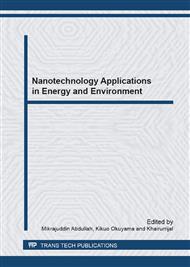p.80
p.85
p.93
p.98
p.105
p.110
p.119
p.126
p.133
Influence of Surface Morphology of Textured Substrate against Poly-Si Thin Film Solar Cells Performance
Abstract:
Since poly-Si is an indirect band gap material and has low optical absorption coefficient in the visible-infrared region, the light trapping in thin film poly-Si layer by using textured substrate is one of the important technical issue for achievement of high short current. Surface texture of a transparent conductive oxide (TCO) layer on a glass substrate as well as SnO2 with a large grain are usually utilized for the light-trapping technique, i.e., path lengths of the incident light in the poly-Si layer are effectively enhanced by the light-scattering at the textured surface. In this paper, a systematic investigation has been carried out concerning the relationship between poly-Si thin film solar cells performance and surface morphology of substrate texture as a function of root mean square roughness of substrate surface, in order to find the optimum textured substrate and realize the light trapping in the poly-Si solar cells. Furthermore, the influence of textured substrate on optical reflectance, poly-Si microstructure and photovoltaic performance are also discussed.
Info:
Periodical:
Pages:
105-109
Citation:
Online since:
January 2013
Authors:
Keywords:
Price:
Сopyright:
© 2013 Trans Tech Publications Ltd. All Rights Reserved
Share:
Citation:



